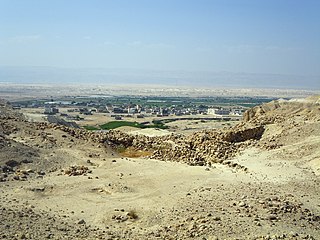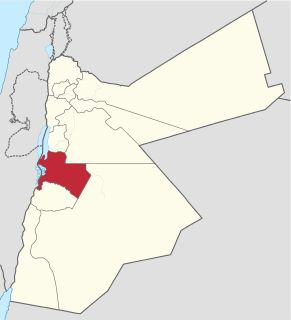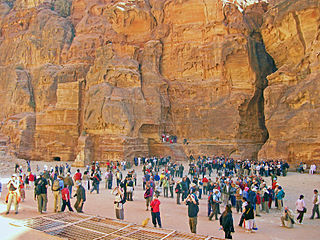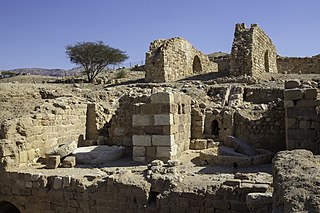
Madaba is the capital city of Madaba Governorate in central Jordan, with a population of about 60,000. It is best known for its Byzantine and Umayyad mosaics, especially a large Byzantine-era mosaic map of the Holy Land. Madaba is located 30 kilometres south-west of the capital Amman.

Dhiban, known to the Moabites as Dibon, is a Jordanian town located in Madaba Governorate, approximately 70 kilometres south of Amman and east of the Dead Sea. Previously nomadic, the modern community settled the town in the 1950s. Dhiban's current population is about 15,000, with many working in the army, government agencies, or in seasonal agricultural production. A number of young people study in nearby universities in Karak, Madaba, and Amman. Most inhabitants practice Islam.

Zoara, the biblical Zoar, previously called Bela, was one of the five "cities of the plain" – a pentapolisat that time of Abram or Abraham named later, it was a highly fertile valley apparently located along the lower Jordan Valley and the Dead Sea plain and mentioned in the Book of Genesis. It was said to have been spared the "brimstone and fire" which destroyed Sodom and Gomorrah in order to provide a refuge for Lot and his daughters. It is mentioned by Josephus; by Ptolemy ; and by Eusebius and Saint Jerome in the Onomasticon.

Bab edh-Dhra is the site of an Early Bronze Age city located near the Dead Sea, on the south bank of Wadi Kerak with dates in the EB IB, EB II, EB II-III and EB IVA. Bab edh-Dhra was discovered in 1924 on an expedition led by William F. Albright. Artifacts from Bab edh-Dhra are on display at Museum at the Lowest Place on Earth, Jordan; Karak Archaeological Museum in Jordan; the Kelso Bible Lands Museum housed at Pittsburgh Theological Seminary in Pittsburgh, PA, USA; The Gustav Jeeninga Museum of Bible and Near Eastern Studies in Anderson, IN, USA; and the British Museum in London.

Karak is one of the governorates of Jordan, located south-west of Amman, Jordan's capital. Its capital is Al Karak. It s bordered by Madaba and the Capital governorates to the north, Ma'an Governorate to the east, Tafilah Governorate to the south, and the Dead Sea to the west.

Madaba is one of the governorates of Jordan. It is located southwest of Amman, the capital of Jordan, and its capital is Madaba. The governorate is ranked 8th by population and by area. It is bordered by Balqa Governorate to the north, The Capital Governorate to the east, Karak Governorate to the south and the Dead Sea to the west.

Abila was an ancient city east of the Jordan River in the Plains of Moab, later Peraea, near Livias, about twelve km northeast of the north shore of the Dead Sea. The site is identified with modern Khirbet el-Kafrayn, Jordan and identified on the Madaba Map as an unnamed icon. There is a widely supported theory that in the Hebrew Bible, it is referred to as Abel-Shittim, as well as in the shorter forms Shittim and Ha-Shittim.

Jordan is a sovereign Arab state in the Middle East. The capital, Amman, is Jordan's most populous city as well as the country's economic, political and cultural centre.
The antiquities trade is the exchange of antiquities and archaeological artifacts from around the world. This trade may be illicit or completely legal. The legal antiquities trade abides by national regulations, allowing for extraction of artifacts for scientific study whilst maintaining archaeological and anthropological context. The illicit antiquities trade involves non-scientific extraction that ignores the archaeological and anthropological context from the artifacts.

Archaeology or archeology is the scientific study of human activity through the recovery and analysis of material culture. The archaeological record consists of artifacts, architecture, biofacts or ecofacts, sites, and cultural landscapes. Archaeology can be considered both a social science and a branch of the humanities. In Europe it is often viewed as either a discipline in its own right or a sub-field of other disciplines, while in North America archaeology is a sub-field of anthropology.

Gerald Lankester Harding was a British archaeologist who was the director of the Department of Antiquities of Jordan from 1936 to 1956. His tenure spanned the period in which the Dead Sea Scrolls were discovered and brought to public awareness. Without his efforts many of the scrolls might have disappeared into private collections never to be seen again.
Tall Jawa is an archaeological and historical site in central Jordan.
Tall al-’Umayri is an archaeological dig site in western Jordan that dates from the Early Bronze Age to the Hellenistic period. It is located near the modern capital of Amman, and is significant for its well-preserved evidence of a temple, as well as archaeological evidence of a network of small farms believed to produce wine. Excavations were proceeding as of 2014.
Jalul is an archaeological site and small village in the Amman Governorate in northwestern Jordan.
The American Center of Research (ACOR) is a private, not-for-profit academic institution & consortium, research library, and hostel. Based in Alexandria, Virginia, with a facility in Amman, Jordan, ACOR promotes the study of the MENA region, with an emphasis on the past and present of Jordan. The institution is a member of the American Schools of Oriental Research (ASOR) and the Council of American Overseas Research Centers (CAORC). Prior to 2020, ACOR was known as The American Center of Oriental Research.

Callirrhoe or Callirrhoë is an archaeological site in Jordan in which remains of a nymphaeum can be traced, though it is considered difficult to be interpreted. Callirrhoe is known in ancient literature for its thermal springs, because it was visited by King Herodes according to Josephus shortly before his death, as a final attempt to be cured or relief his pains. It remains unknown if the greatest builder in Jewish history is related to any of the observable remains in the area. Callirrhoe is referred by Pliny the Elder, Ptolemaeus and Solinus as well as in a Midrash.

Burton MacDonald is a Canadian biblical archaeologist specialising in the archaeology of Jordan. He has been a professor at St. Francis Xavier University since 1965 and is currently Professor Emeritus in the Religious Studies department.

Tell el-Hammam is an archaeological site in Jordan, in the eastern part of the lower Jordan Valley close to the mouth of the Jordan River. The site has substantial remains from the Chalcolithic, Early, Intermediate and Middle Bronze Age, and from Iron Age II. There are different attempts at identifying the site with a biblical city.
The Book of Joshua lists almost 400 ancient Levantine city names which refer to over 300 distinct locations in Israel, the West Bank, Jordan, Lebanon and Syria. Each of those cities, with minor exceptions is placed in one of the 12 regions, according to the tribes of Israel and in most cases additional details like neighbouring towns or geographical landmarks are provided. It has been serving as one of the primary sources for identifying and locating a number of Middle Bronze to Iron Age Levantine cities mentioned in ancient Egyptian and Canaanite documents, most notably in the Amarna correspondence.

Ghor es-Safi is an area in the Jordan valley, located in the Wadi al-Hasa. It is situated between the governorates of Karak and Tafilah, near the southern Dead Sea. The location is depicted on the 6th-century Madaba map as "Zoara."